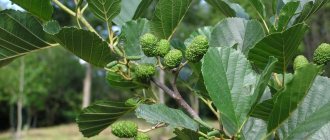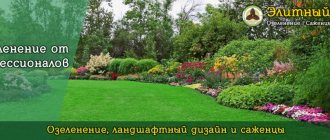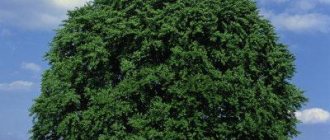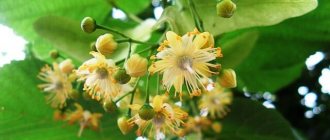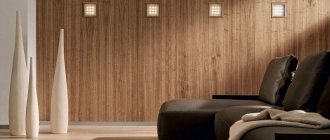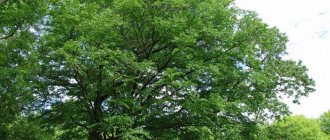Where does the linden tree grow?
The genus Linden (Tilia - lat.) belongs to the Malvaceae family and unites more than 45 species of trees and shrubs. These beautiful deciduous plants can be found almost throughout Russia from the Caucasus to Arkhangelsk, in Siberia and the Far East. Throughout Europe as far as Finland, as well as in China and North America.
In our country, in Bashkiria, Tatarstan, and Chuvashia, entire forest areas grow. In the Kuzbass in the west of the Kuznetsk Alatau there is a forest with a huge territory of 11 thousand hectares, called “Linden Island”. In 1983, by government decree, it was given the status of a living natural monument. 23 species of linden grow in this place, not counting oaks and conifers.
In Russia, the most common species is the small-leaved, heart-shaped linden, but Siberian, Amur, Far Eastern, and Khabarovsk linden are also found. There are American, Chinese and other lindens.
Depending on the species, an adult tree can reach 120 years of age and grow up to 30-40 meters. There are specimens that are already 500-600 years old, and in Germany there is a linden tree that has reached 1200 years old and is unique.
Linden - a tree with the aroma of honey: description and medicinal properties
Midsummer is especially beautiful with its fragrance; the linden tree begins to bloom. We can hear the hum of bees around and we can inhale the aroma of honey. The linden tree is the most respected tree among the Russian people. Settlements and even mountain systems and forests were named after this plant.
Many names for women came from the name of this tree. And the month of July is named after the linden tree by the Ukrainian population. Linden is associated with feminine affection and kindness. The linden tree was also the mother tree and was equated with divine plants.
They say that linden can feed, put on shoes and give health.
Many household items used to be carved from linden wood. And the honey from linden nectar turned out simply excellent.
Appearance of linden tree
- Bark. Young trees have smooth, shiny, reddish bark. With age it becomes dark and rough, covered with cracks.
- Leaves. The leaves of the plant are bright green in summer and yellow in autumn. They have oblique-oval, heart-shaped, oblique-heart-shaped shapes. The edges are wavy or ribbed (serrated). Dimensions depend on the species, usually 6-9 cm.
- Color. Linden flowering begins, depending on the region of growth, from mid-June to early July and lasts about two weeks. The flowers are small, golden or cream-colored, collected in umbrellas of 3-8 pieces, hanging in whole clusters. Each flower has five petals, five sepals, many stamens and one pistil.
- Seeds. In autumn, small round or oval nuts, ribbed or not, ripen on the tree. These seeds are attached in 2-3 pieces on petioles with wings. In autumn and winter, the wind tears them from the tree and carries them quite far.
How to draw a linden tree with a pencil and paints step by step?
How to draw a linden tree with a pencil and paints step by step?
Linden is a beautiful tree. When it blooms, the air smells delicious of honey. Drawing a linden tree is not difficult. To do this, you need to have an idea of what a tree leaf looks like and the flowers that appear in the spring. First, let's draw a base that is suitable for depicting any deciduous tree. We draw with a pencil the trunk, branches and outline the crown of the future linden tree:
In order for a linden tree to become a linden tree, you need to depict only its characteristic details, namely the leaf, flower and fruit of the linden tree. Up close they look like this:
In order to make it clear that this is a linden tree, we need to draw the tree as large as possible so that the leaves are visible. For example like this:
Be sure to draw the underleaf, flowers and fruits, which distinguish this tree from many others. If you depict it in color, you need to remember: the linden leaf is bright green with jagged edges and many veins, the flowers are small white. It looks like this in linden color:
Linden tree propagation
There are several ways to propagate linden: by seeds, layering, cuttings, grafting.
- The longest method is seed propagation.
- The nuts need to be soaked for several months in damp sawdust at a temperature of 0 +4.
- Then they are planted in boxes with loose fertilized soil.
- But even all the manipulations do not guarantee greater germination.
- A tree grown from a seed reaches maturity only by the age of 12.
Cuttings are also not a reliable method; the branches do not take root well. Grafting and layering are more convenient methods. Rooted cuttings are then planted in parks and along roads.
Reproduction and care
Planting linden trees is a great way to create a beautiful landscape, suitable for home areas, squares and parks. These trees improve the microclimate, fill the air with a pleasant aroma of flowers in summer, and when planted outside the city, they allow you to collect and use useful flowers.
It is possible to propagate trees by seeds, but it is very labor-intensive and time-consuming. Not all of them retain germination, and, given the long dormant period, it can take more than one year for seedlings to emerge. It is much more rational to use layering or root shoots of linden as planting material. To root the layering, the lower lateral shoots are tilted to the soil and secured by lightly sprinkling it. You will have to wait 1-2 years for the roots, then the branches just need to be freed from the soil and separated from the tree. They do this at the end of March.
New shoots shoot up from the linden roots quite often; you just have to carefully disconnect them from the mother plant. You can also purchase ready-made seedlings.
For planting, a mixture of turf soil, humus and sand is preferable. The holes are dug in proportion to the size of the roots of the seedlings, so that their upper part is flush with the surface. Drainage made of broken bricks or small stones is laid at the bottom. The distance between holes when planting several trees is at least 3 m.
Young linden trees require careful care. In the first 2–3 years, weekly watering is required, fertilizing at least once a month with nitrogenous fertilizers. For the winter, it is important to insulate the seedlings with mulch made from sawdust or pine needles. Mature trees do not need to be watered, but need to be fertilized 1-2 times a season.
They begin to trim branches to form a crown no earlier than the third year of life.
Linden wood
Characteristics. When cut, linden has a uniform light white or slightly brownish color and does not darken over time. The rings are thin, not very pronounced, the texture is smooth and shiny.
Linden wood has a low density, which increases significantly as it dries out. The volume shrinkage coefficient is high - 0.58. Has poor resistance to rotting.
Why doesn't the linden tree bloom?
It is worth considering that most linden varieties do not tolerate the southern climate well. An incorrectly selected variety may not begin to bloom in such regions at all. Many varieties are also characterized by slow growth, which is often confused with a disease that caused a lack of flowering.
Common reasons for lack of flowering are:
- incorrectly selected variety for certain climate conditions;
- excessive or low soil moisture;
- incorrectly chosen landing site.
The same reasons may also be why the linden tree does not bloom every year.
Application of wood
Linden is well used in crafts: for making handicrafts, wooden dishes, boxes, nesting dolls, and wood carvings. Thanks to its softness, cutting, sanding, and impregnation will not cause difficulties.
It will be very successful to use linden for the interior lining of a bathhouse, because... the material does not heat up much, but retains heat for a long time without emitting foreign odors. Also suitable for interior cladding.
Linden is also used to make musical instruments due to its good flexibility and acoustic properties.
Linden holds its shape well, so drawing boards, plywood, pencils, food containers, and barrels are made from it.
The benefits of linden blossom
Linden collection is very good for health. It is used both separately and with other herbs in combination. Linden has antipyretic, diaphoretic and anti-inflammatory effects.
- Helps you relax as well as valerian.
- The decoction is used to gargle and as an expectorant.
- Helps with weight loss, because... removes excess fluid from the body.
Flowers begin to be collected at the beginning of flowering, when 3-4 flowers from the entire inflorescence have bloomed. They are picked with a whole umbrella and dried in a shaded place. The raw material dries out approximately three times, this should be taken into account when preparing.
The scope of application of linden color is extensive, but it is not suitable for permanent use. Don't overuse it, everything is good in moderation.
Beneficial features
Our ancestors knew about the benefits of linden. All parts of the linden tree have beneficial properties. Linden color relieves cramps, pain, relieves inflammation and removes sweat and urine from the body. It is also useful to make decoctions and tinctures from flowers, and gargle when you have a cold. Flowers effectively fight harmful bacteria in the body, reduce fever, and get rid of phlegm. For teenagers and old people, linden is useful for its calming properties, which help with mood swings and nervous overexcitation. The inflorescences also help reduce blood viscosity.
Linden decoctions are used for fainting and headaches, which helps relieve convulsive conditions. Hot decoctions are used in the form of inhalations and gargling. In addition, linden blossom is successfully used in the treatment of rheumatism of the joints, seizures, kidney and gastrointestinal diseases, and fever. For a healing effect, take a decoction of 2-3 glasses per day. Prepare a decoction at the rate of 2 tablespoons of linden blossom per glass of boiling water. This allows for increased secretion of gastric juice, which facilitates the flow of bile into the duodenum. This has a beneficial effect on the digestive system and helps fight gastritis and liver diseases. Decoctions help get rid of swelling and weight loss.
Linden lotions effectively help with hemorrhoids, burns, gout and ulcers. Compresses are used to eliminate skin irritation. Rinsing with linden decoctions is very beneficial for hair, which makes it shiny and smooth.
Linden is very useful in the treatment of infertility, due to the content of phytohormones in it, which are similar in composition to female hormones. For conception, it is recommended to add linden to medicinal mixtures with sage.
READ pine from Italy – Pinia
Linden tea has unique healing properties for the body. This golden-hued drink has a sweetish taste and pleasant aroma. First of all, linden tea is useful in the cold season, when you can easily get the flu and other colds. Tea has an anti-inflammatory effect, stimulates sweating, expectoration and has an antipyretic effect. Tea also effectively removes toxins from the body. It has a beneficial effect on the urinary tract and is useful for urolithiasis, cystitis and inflammation of the bladder.
Linden tea is also useful in the following cases:
- To strengthen the cardiovascular system. The flavonoids included in its composition strengthen blood vessels and make them more elastic, protecting them from sclerotic changes.
- To eliminate pain in the body. Tea relieves headaches, spasms, joint pain, and also removes swelling in the body.
- To activate digestion. Tea stimulates the production of bile, which has a beneficial effect on the digestive processes.
- To relieve nervous tension and combat insomnia.
To prepare this aromatic healing drink, use linden blossom: pour one tablespoon of flowers into a glass of hot water and leave for 15-30 minutes, tightly covering the kettle. In addition, you can add honey to your tea. For convenience, pharmacies and specialized stores sell ready-made linden teas in bags.
However, there are several cautions regarding drinking linden tea. It should not be taken regularly as it increases the stress on the heart.
Linden has long been considered a female tree. This is due to the fact that it contains phytohormones that are beneficial for the female body. Phytohormones are similar in composition to female sex hormones. They help a woman restore an imbalance in the hormonal system. Therefore, it is especially useful for women to drink tea, decoction or infusion of linden in the following cases:
- For menstrual irregularities. It is recommended to drink the drink, brewed twice: the flowers are poured with hot water, infused, then kept on low heat for 30 minutes. This will allow you to extract the maximum amount of healing substances.
- For discomfort during menopause. Drinking tea daily helps avoid hormonal imbalances, which are stabilized by phytohormones.
- In the fight against neoplasms in the female genital organs - fibroids and myomas. Traditional healers emphasize that in order to obtain the expected effect, it is necessary to collect flowers during the first two days of the lunar month.
Thanks to the diuretic effect of the plant, you can effectively lose weight and get rid of excess fluid in the body. It is recommended to drink infusion or tea when visiting a sauna or steam bath. This will help improve metabolism, remove waste and harmful toxins, and at the same time, even out hormonal fluctuations.
Recommended recipe for losing weight using linden:
- birch sap – 450 g;
- linden leaves – 50 g;
- rhubarb decoction – 0.5 l.
Mix all ingredients and steam for 5 minutes. Leave to sit for 30 minutes. Take 0.5 cups before meals.
Recipes for therapeutic nutrition from linden
Linden seeds are very nutritious
, they are used in the same way as hazelnuts or walnuts, from them an oil is obtained that is close in quality to olive oil and tastes like almond oil. Fresh leaves are used to make salads, dried leaves are added to dough.
Salad of linden and dandelion leaves
Young linden leaves are washed, finely chopped and mixed with chopped dandelion leaves, green onions and dill. Season with sour cream or vegetable oil. Linden leaves - 50 g, dandelion leaves - ZOg, green onions, dill, 1 tablespoon of sour cream or vegetable oil, salt. Young leaves are dried and stored in paper bags. Dried leaves, ground into powder, are added to the dough for vitaminization.
Linden flower jam
The flowers are cut off from the stalks, placed in a colander, washed with water and placed in an enamel bowl. Prepare syrup (400 g of sugar, 1 liter of water per 1 kg of flowers), boil it, filter and pour boiling syrup over the flowers, ensuring that they are completely immersed in the syrup. In 5min. add citric acid (3 g per 1 kg of flowers) until the end of cooking. The finished jam is packaged in sterile jars and cooled.
Linden is popularly called unmercenary. “Whoever approaches the linden tree will leave with goodness, the leaf will be prepared and the cattle will be fed, it will shelter from the heat and rain, it will calm the heart. The bee will collect honey, the owner will leave with a broom, he will put on shoes, dress, drink, warm, and drive away the evil cold. Whoever plants a linden tree is remembered by people, God prolongs his life.”
Linden honey
Linden honey is considered to be the most beneficial in the world. Contains many trace elements, amino acids, vitamins and enzymes. It helps with colds and inflammation, improves the functioning of the cardiovascular, nervous and respiratory systems of the body. Helps with the functioning of the liver, kidneys and gall bladder.
Linden is simply an excellent honey plant. In a good year, bees collect more than 1000 kg of honey from one hectare of linden plantations.
Chemical composition
Linden contains many substances beneficial to the body. The buds, inflorescences and bark contain glucose, protein, vitamin C, tannins, antioxidants, essential oils, sugar, amino acids, carotene, microelements, macroelements and phytoncides. Tiliacin, quercetin and kempforol contained in linden provide antibactericidal, wound-healing and antipyretic properties. The flowers also contain ascorbic acid, farnesol alcohol-based essential oil and polysaccharides.
The leaves contain protein, carotene and ascorbic acid.
Linden honey is rich in glucose, fructose, vitamins, macroelements and microelements, as well as maltose.
Linden blossom contains vitamin C, coumarin, bioflavonoids, carotene, micro- and macroelements, glucose.
Landscape gardening
Linden is very often used in landscape design, because it has beautiful and dense foliage and tolerates pruning easily. It is easy to create any geometric shape from the crown.
Planting and care
In order for the linden to grow well, you need to perform all planting manipulations correctly .
Initially, it is necessary to dig a planting hole, the width and depth of which should be within 60 cm. A uniform layer of drainage 15-20 cm thick is laid at the very bottom. In this case, you can use broken brick, pebbles, expanded clay, and ceramic shards. After this, a layer of humus and superphosphate is laid (no more than 60 grams per hole). Only now can you safely place the seedling.
It is worth noting that the root collar must be at the same level as the soil surface . If several young linden trees are planted at a time, the distance between two trees should be at least 5 meters. If seedlings are purchased from a nursery or from a trusted gardener, then special attention should be paid to the condition of the root system (it should look healthy and strong). This is due to the fact that the absence of signs of damage by parasites and diseases, as well as the correctness of the crown, affect the appearance and longevity of the crop.
READ Types and varieties of mountain pine
As for care, after planting the young tree needs to be watered abundantly and special fertilizers applied . During the first two years, the crop is fed with mineral and organic components (3-4 times per season). Experienced gardeners often use mullein infusion, which is diluted in clean water (ratio 1:10).
An adult linden tree is fed 2 times a year: in the fall - nitroammofoska (25 grams per bucket of water), in the spring - mullein infusion. The very next year after planting, you can safely begin cultivating the tree. The first pruning is done before the buds open. But it is better not to shorten the crown by more than a third of the total length of the branches.
A little history
In the old days, nobles planted linden alleys around their estates. They loved to walk in the shade of the dense, beautiful crowns. Some plantings have survived to this day in the form of parks.
Until the twentieth century, the main shoes of peasants were bast shoes. One peasant wore out up to 40 pairs of bast shoes per year. And for each pair it was necessary to peel off 2-3 young stickies. They made both bast and matting from it.
In many countries, linden was considered a sacred tree; it was planted near churches, and rituals were performed under it.
